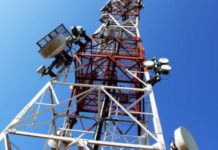By Aaron Ukodie

The required spectrum for the operation and management of drones in Nigeria has been allocated and would be available for use soon.
Also the 60 GHz Spectrum band to boost the imminent advantages that are coming with 5G technology and also to support indoor short range machine to machine communication has been opened for use.
Spectrum refers to a range of radio-waves that are used for communication purposes.
The announcement was made by the Executive Vice Chairman of the Nigerian Communication Commission ( NCC) Prof. Umar Danbatta.
Danbatta spoke at the stakeholders consultative Forum On regulation of drone: the spectrum perspective, and presentation of reviewed guidelines on 2.4 and 5.8Ghz spectrum bands held today at Sheraton Hotesl, Lagos. The forum was organized by the NCC, with several security officials and operators of drone attending.
He said all the “aforementioned Spectrums are license-free but regulated…” but “all equipment to be used must be dully type approved in accordance with the Commission’s Type Approval Regulation.
He said “the 60 GHz global unlicensed band which exists on 57–64 GHz, a wide Spectrum of up to 7 GHz is now officially open to Nigerians and will in due course be available for use after necessary work is completed on the guidelines”.
According to Danbatta the new spectrum initiative will complement the Spectrum in the 2.4 GHz and 5 GHz unlicensed bands currently being utilized in the country.
The forum was organized by the Commission to demonstrate effort of the Commission at providing requisite Spectrum for the deployment of drones technology and to listen to your views on the subject matter.

There was a presentation of the reviewed guidelines on the use of 2.4GHz and 5.8GHz bands respectively to accommodate the emerging technology, at the forum.
He said the guidelines for the use of 2.4GHz and 5.8GHz Spectrum bands is presently limited in its condition of use and therefore requires amendments.
Danbatta added that the new draft guidelines have incorporated some changes which include but not limited to Duty cycle, Transmission, Reception Frequencies, Power, Distance, Speed and Weight.
The idea of the new changes, he noted, is so as to give an added opportunity to the use of drones in the bands without causing interference to the adjacent and incumbent services.
The EVC said the frequencies which are currently unlicensed and are not allocated strictly for the utilization of drones in Nigeria, but the Commission has temporarily identified and modified some conditions in the guidelines and authorized the operators, cleared by the Office of the National Security Adviser (ONSA), to use them in response to the request from the ONSA to temporarily use the Frequencies pending the revision of the guidelines.
In a speeDirector of Spectrum Administration Austin Nwaulune, the established technical parameters to use the 2.4 and 5.8 GHz bands as the frequency for deployment of drones and other emerging technologies in other to maximise their benefits.
He said though the Commission has had guidelines on both the use of 2.4 GHz and 5.8 GHz Bands for Wireless Access System (WAS the prevailing guidelines do not cover the general requirement for the control of drones and payload links such as on-board cameras, sensors, etc.











